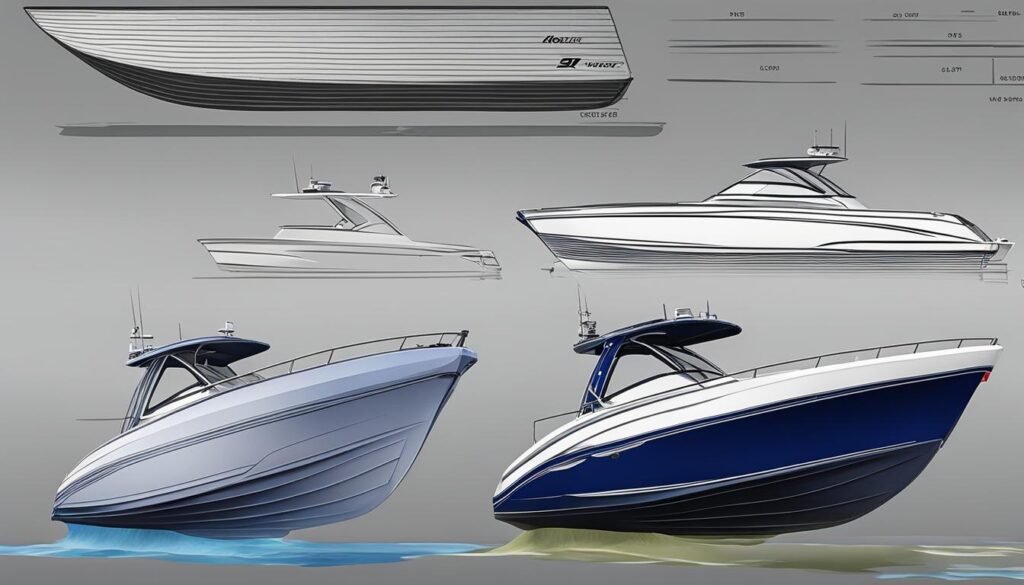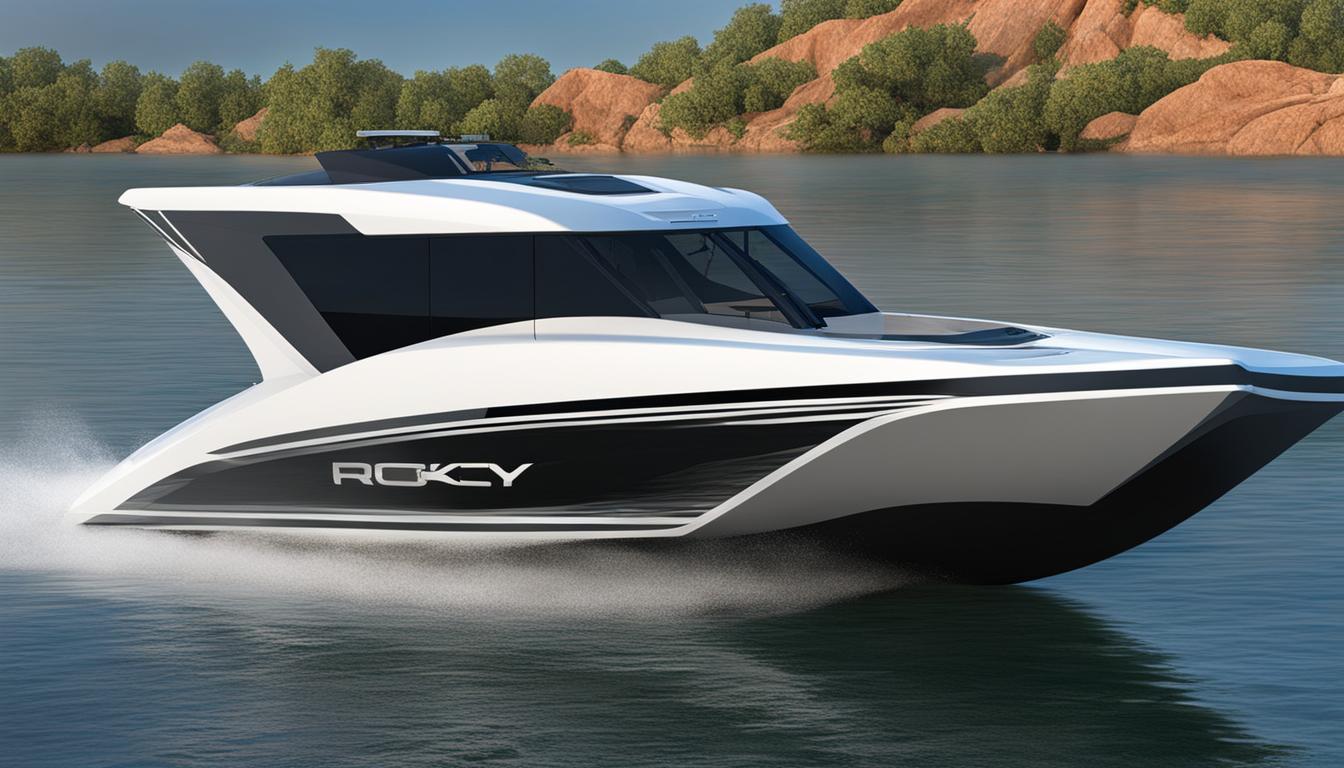The hull of a boat plays a critical role in its performance on the water. It determines stability, buoyancy, and maneuverability, making it essential to consider the specific water conditions when designing a hull. Whether you’re navigating whitewater rapids or fishing in calm lakes, custom hull designs can optimize your boating experience. Let’s explore the key considerations for hull design in various environments.
Key Takeaways:
- Hull designs should be tailored to specific water conditions.
- Consider the intended use, such as whitewater rapids or fishing, when choosing a hull design.
- Stability, speed, handling, and fuel efficiency are important factors to consider in hull design.
- Deep-V hulls, displacement hulls, and pontoon hulls are specialized designs for specific purposes.
- Consulting with experts can help determine the best hull design for your specific needs.
Common Types of Boat Hulls
When it comes to boat hulls, there are several common types that cater to different needs and water conditions. Understanding these hull designs can help you choose the right one for your boating adventures.
Flat Bottom Hull
The flat bottom hull is characterized by its flat surface, making it ideal for navigating calm and shallow waters. This hull design offers excellent stability, maneuverability, and ease of construction. It is commonly found in small recreational boats, such as jon boats and dinghies.
V-Shaped Hull
The V-shaped hull features a pointed bow that gradually widens towards the stern, forming a V-shape. This design is known for its ability to cut through waves and provide a smoother ride in rough conditions. The V-shaped hull offers better performance in terms of speed and fuel efficiency, making it popular for larger powerboats and offshore vessels.
Round Bottom Hull
The round bottom hull has a curved shape from bow to stern, providing stability and maneuverability. This design is commonly found in traditional sailboats and some kayaks. The round bottom hull allows for efficient tracking and sail performance, making it suitable for cruising and recreational purposes.
Planing Hull
The planing hull is designed to lift the boat out of the water, allowing it to glide on the surface and achieve higher speeds. This hull design is commonly used in powerboats, speedboats, and water sports vessels. The planing hull sacrifices some stability for increased speed and agility.
Cathedral Hull
The cathedral hull is characterized by its two or more V-shaped hulls running parallel along the centerline of the boat. This design offers exceptional stability and fuel efficiency. It is commonly used in pontoon boats and some catamarans, providing ample deck space and comfort for recreational activities.
Understanding the different types of boat hulls will help you make an informed decision when choosing a vessel for your specific needs. Whether you prefer stability, speed, or maneuverability, there is a hull design that can accommodate your boating style.

Specialized Hull Designs
When it comes to boat hulls, there are specialized designs that cater to specific purposes. These unique hull types are engineered to provide optimal performance and functionality in various water conditions. Let’s explore three of these specialized hull designs: Deep-V hulls, Displacement hulls, and Pontoon hulls.
Deep-V Hulls
The Deep-V hull design is characterized by a sharp V-shaped bottom that extends towards the bow of the boat. This type of hull is commonly found in offshore powerboats and is specifically engineered for high-speed performance. The Deep-V hull allows the boat to cut through waves and rough waters with ease, providing a smoother and more stable ride even in challenging conditions. This makes Deep-V hulls ideal for boaters looking for speed and agility while maintaining control and stability.
Displacement Hulls
Displacement hulls are often seen in large cruising sailboats and trawlers designed for long-range cruising. These hulls are optimized for efficiency and comfort, offering a smooth and steady ride through the water. Unlike planing hulls that lift the boat out of the water at higher speeds, displacement hulls are designed to displace water as they move, minimizing resistance and maximizing fuel efficiency. The displacement hull’s long and narrow shape allows it to cut through the water, making it an excellent choice for boaters seeking long-distance travel and extended time on the water.
Pontoon Hulls
Pontoon hulls are known for their stability and versatility, making them popular choices for recreational and party boats. These hulls feature multiple airtight compartments called pontoons that provide buoyancy and stability. Pontoon hulls offer ample deck space, making them ideal for various activities such as fishing, sunbathing, and entertaining. Their wide beam provides excellent stability, allowing passengers to move about the boat with ease, even in choppy waters. Pontoon hulls are a fantastic option for those seeking a comfortable and spacious boating experience.
| Hull Design | Specialty |
|---|---|
| Deep-V Hulls | High-speed performance in rough waters |
| Displacement Hulls | Efficiency and comfort for long-range cruising |
| Pontoon Hulls | Stability and versatility for recreational activities |
Each of these specialized hull designs offers unique advantages depending on your boating needs. Whether you’re looking for speed, long-distance cruising, or a comfortable recreational experience, there’s a hull design tailored to suit your preferences. Understanding the characteristics and benefits of these specialized hulls will help you make an informed decision when choosing the right hull for your boating adventures.
Choosing the Right Hull for Your Needs
When it comes to selecting the right hull for your boat, there are several factors to consider. Whether you’re seeking stability in rough waters, custom configurations for speed, or specific hull shapes for touring kayaks, understanding your boating goals and intended use is essential.
Start by evaluating your desired activities and the environment in which you’ll be boating. If you plan to venture into rough waters, opt for a hull design that prioritizes stability. Look for hulls with a deeper V shape or a modified cathedral hull, as these designs offer better handling in choppy conditions.
For those in pursuit of speed, custom hull configurations can make all the difference. Look for hulls specifically designed to reduce drag and enhance performance. These hulls may feature a flatter bottom or a sleeker, more tapered shape.
If you’re considering a touring kayak, hull shape is crucial. Look for a kayak with a longer, narrower hull design to optimize speed and maneuverability. This will allow you to glide through the water with ease, making your kayaking adventures more enjoyable.
Ultimately, the decision on the right hull comes down to your specific needs and preferences. Consulting with boat designers, manufacturers, or experienced boaters can provide valuable insights and guidance to help you make an informed choice.

Hull Design Considerations
When it comes to hull design, several factors play a crucial role in determining the overall performance of a boat. Understanding these factors will help you make an informed decision when choosing the right hull for your needs. Factors influencing hull design include stability, draft, speed and efficiency, and handling and maneuverability.
Stability: The shape and width of the hull significantly impact stability. A wider hull provides greater stability, making it less prone to tipping or rolling. On the other hand, a narrow hull offers improved speed but may sacrifice stability, especially in rough waters.
Draft: Draft refers to the depth of a boat’s hull below the waterline. A shallow draft allows boats to navigate in shallower waters, making them ideal for exploring coastal areas or rivers. However, deeper drafts are necessary for larger boats or when sailing in deeper waters.
Speed and Efficiency: The hull design plays a crucial role in a boat’s speed and fuel efficiency. Planing hulls, for example, are designed to lift the boat out of the water, reducing drag and allowing for higher speeds. On the other hand, displacement hulls are more efficient at slower speeds, making them perfect for long-range cruising.
Handling and Maneuverability: The shape of the hull impacts a boat’s handling and maneuverability capabilities. V-shaped hulls provide a smoother ride and better performance in rough conditions, while flat bottom hulls offer stability and maneuverability in calm waters. Consider your boating activities and the water conditions you’ll be navigating to choose a hull design that provides optimal handling and maneuverability.
| Factors | Influences |
|---|---|
| Stability | Hull shape and width |
| Draft | Water depth and vessel size |
| Speed and Efficiency | Type of hull (planing or displacement) |
| Handling and Maneuverability | Hull shape and design |
Conclusion
Understanding the intricacies of boat hulls is essential for boaters like you. Innovations in hull design have brought about adaptations specifically for fishing kayaks and tailored designs for diverse environments. By selecting the appropriate hull design, you can enhance your boat’s performance in various water conditions, ensuring a safe and fulfilling boating experience.
Whether you’re navigating rough waters or cruising calm lakes, advancements in hull design cater to your specific needs. These innovations ensure stability, maneuverability, and speed, allowing you to tackle any water condition with confidence.
For fishing enthusiasts, hull design adaptations for fishing kayaks provide the perfect balance of stability and functionality. These specialized hulls are designed to optimize your fishing experience, offering stability for casting and reeling in your catch.
When it comes to choosing a hull, remember that customization is key. Tailored hull designs for specific environments ensure that your boat performs optimally in its intended setting. Whether you’re exploring rivers, lakes, or the open ocean, a well-suited hull design can make all the difference in your boating adventures.
FAQ
What factors should I consider when choosing a boat hull?
Factors to consider when choosing a boat hull include your boating goals, intended use, water conditions, desired activities, environment, boat size, and passenger capacity.
What are the common types of boat hulls?
The common types of boat hulls include flat bottom hulls, V-shaped hulls, round bottom hulls, planing hulls, and cathedral hulls.
Are there specialized hull designs for specific purposes?
Yes, there are specialized hull designs such as deep-V hulls for high-speed performance, displacement hulls for long-range cruising, and pontoon hulls for stability and deck space.
How does hull design impact boat performance?
Hull design impacts boat performance through factors such as stability, draft, speed and efficiency, and handling and maneuverability.
How can I choose the right hull for my needs?
To choose the right hull, consider your boating goals, intended use, and water conditions. Consulting with boat designers, manufacturers, or experienced boaters can help determine the best hull for your needs.
What are the factors that influence hull design?
Factors that influence hull design include stability, draft, speed and efficiency, and handling and maneuverability. The shape and width of the hull impact stability, while the draft affects the boat’s ability to navigate shallow waters.





